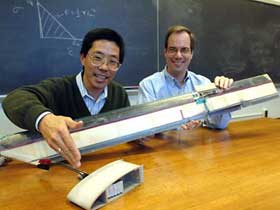MIT engineers report they may have found a way for structures — and materials — to morph from one shape into another. The discovery could lead to an airplane that morphs on demand from the shape that is most energy efficient to another better suited to agility, or to a boat whose hull changes shape to allow more efficient movement in choppy, calm or shallow waters.
 Components of the electrochemically actuated morphing rotor prototype (foreground) as well as a model (background) of a previous technology that uses piezoelectrics as the active materials
Components of the electrochemically actuated morphing rotor prototype (foreground) as well as a model (background) of a previous technology that uses piezoelectrics as the active materials
Batteries expand and contract as they are charged and recharged. “I thought we could use this behavior to another end: the actuation, or movement, of large-scale structures,” said Professor Yet-Ming Chiang.
The team have already demonstrated basic battery-based actuators that can pull and push with large force. Later this year, they hope to demonstrate the shape-morphing of a helicopter rotor blade. The morphing capability should allow for a more efficient design, ultimately making it possible for a vehicle to carry heavier loads. Team members say that other applications, including miniaturized devices for Micro-Electrical-Mechanical Systems), may flow from these initial demonstrations.
The researchers emphasize that much work remains to be done, however, says Chiang, “we’ve been able to demonstrate the potential of this approach even using these very unoptimized off-the-shelf batteries.”
Via MIT News Office.
